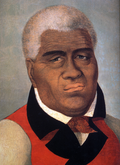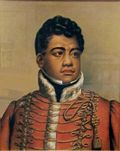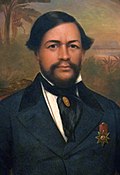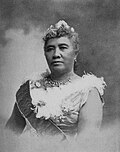Monarchy of Hawaii
| Prince of Hawaiʻi | |
|---|---|
 Royal coat of arms | |
| Incumbent | |
 | |
| Kawānanakoa | |
| Details | |
| Style | See below |
| Heir apparent | Kincaid, Hereditary Prince of Hawaii |
| First monarch | Kamehameha I |
| Residence | ʻIolani Palace |
| Appointer | Hereditary |
| Hawaii |
 This article is part of the series: |
|
|
|
The Crown
|
The monarchy of Hawaii, commonly referred to as the Hawaiian monarchy, is the subnational monarchy of the Principality of Hawaii, a constituent country of the Kingdom of Sierra. The Prince or Princess of Hawaii is the reigning monarch who exercises nominal authority over the Hawaiian Islands but is ultimately subject to the sovereign, temporal authority of the Sierran monarch. The royal institution traces its origins to the ancient monarchies of Hawaii, Oahu, Maui, Kauai, and Molokai, as well as the sovereign monarchy of the defunct Kingdom of Hawaii. The current reigning monarch is Prince Kawānanakoa.
A unified monarchial system was established across the Hawaiian archipelago in 1795 by Kamehameha I following military conquest. He became the sole ruling monarch in the islands after he deposed Kaumalii of Kauai and Niihau, who was the last independent aliʻi nui (supreme ruler) besides Kamehameha. He established the House of Kamehameha, adopted Western customs and titles, including the term "King", and his dynasty remained in power until 1872 when the last Kamehameha monarch, Lunalilo, died without issue and a designated heir. Kalākaua of the House of Kalākaua was elected as Lunalilo's successor and his dynasty reigned until 1893 when Sierran nationals overthrew Kalākua's sister and successor, Queen Liliʻuokalani. The subsequent dissolution of the Kingdom of Hawaii and the annexation of Hawaii by the Kingdom of Sierra resulted in the abolition of the Hawaiian monarchy. The monarchy was reestablished as a subnational principality in 1950 by the Charter for the Kingdom of Sierra, which converted the Territory of Hawaii into a constituent country of the Kingdom. Prince Koke of the House of Kawānakoa became the first post-independent Hawaiian monarch in 1950.
The modern Hawaiian principality is established by the Constitution of Hawaii which recognizes the Prince (or Princess) as the monarch of the Hawaiian polity and Hawaiian nation. It is also recognized by the Sierran federal government as a legitimate institution in the Charter for the Kingdom of Sierra, which is the primary document responsible for the establishment and construction of the Hawaiian state. Although the Sierran monarch remains the supreme head of state of Hawaii, much of the powers and responsibilities of the Sierran monarchy are devolved directly to the Hawaiian monarch, whose role is somewhat analogous to the Lords and Ladies Superintendent of Sierran PSAs. Within Hawaii, the Hawaiian monarch is the nominal head and fount of government, but is still subject to the supremacy and purview of the Sierran monarch, who retains the title of High Chief or Chieftess of Sierra.
Constitutional role
The Monarchy of Hawaii is the head of the Hawaiian polity and is the symbolic representation of the Hawaiian nation as declared by the Constitution of Hawaii. The Prince or Princess is the source of self-government and autonomy in the Hawaiian Islands, who derives their authority ultimately from the Sierran Crown and Parliament. As a subject of the Sierran monarch, the Hawaiian monarch is subordinate to the Occidental Palace. Nonetheless, the Hawaiian monarch is authorized to exercise royal authority in their own name by permission of the Sierran Crown, effectively serving as the Queen's viceregal representative in Hawaii (similar to Lords and Ladies Superintendents in Sierran PSAs and Lords and Ladies Proprietor in Sierran territories).
Much like the Sierran monarch, the Hawaiian monarch's actual involvement and participation in governance is limited by both statute and convention. Much of the Hawaiian monarch's royal prerogatives and powers are vested in the Premier, who is the head of government elected by members of the Hawaii House of Representatives, and other ministers, officers, and bodies of the Crown. As a constitutional monarch, the Hawaiian monarch is mostly relegated non-partisan, ceremonial functions, although they retain the authority to exercise emergency powers, such as summoning or dissolving the Hawaiian National Congress, calling elections, mobilizing the Sierran Crown Armed Forces–Hawaii, or recalling certain government officials including the Premier.
History
Succession
Residence
Style
The full style and title of the current monarch is "Quentin, by the Grace of God, Prince of the Hawaiian Islands, Duke of Kawānanakoa, Governor of the Hawaiian Reformed Catholic Church, Companion of the Queen". The title "Duke of Kawānanakoa" was first granted by King Louis III to Prince David I, when the monarchy of Hawaii was restored in 1950. The title "Governor of the Hawaiian Reformed Catholic Church" reflects the prince's role as the head of the Church of New England's Hawaiian ecclesiastical province, which is known as the Hawaiian Reformed Catholic Church, or the Church of Hawaii. The "Companion of the Queen" (or King) was a title granted by Queen Angelina I to recognize the Hawaiian monarch's loyalty and fidelity to the Sierran Crown.
The monarch is referred to as "His Highness" or "Her Highness", while the form "Hawaiian Highness" appears on international documents, treaties, and passports to differentiate the monarch from other heads of state.
Arms
List of Hawaiian monarchs
Kingdom of Hawaii
| Name | Portrait | Birth | Marriages | Death |
|---|---|---|---|---|
| Kamehameha I Spring, 1795 – May 8, 1819 |

|
c. 1758 Moʻokini Heiau, Kohala, Hawaiʻi island son of Keōua and Kekuʻiapoiwa |
various | May 8, 1819 Kamakahonu, Kailua-Kona, Kona, Hawaiʻi island aged 61? |
| Kamehameha II May 20, 1819 – July 14, 1824 |

|
c. 1797 Hilo, Hawaiʻi island son of Kamehameha I and Keōpūolani |
(1) Kamāmalu (2) Kīnaʻu (3) Kekāuluohi (4) Kalanipauahi (5) Kekauʻōnohi (6) Kekaihaʻakūlou |
July 14, 1824 Caledonian Hotel, London, England aged 27 |
| Kamehameha III June 6, 1825 – December 15, 1854 |

|
August 11, 1813 Keauhou Bay, North Kona, Hawaiʻi island son of Kamehameha I and Keōpūolani |
Kalama Honolulu, Oʻahu 14 February 1837 two sons |
December 15, 1854 Honolulu, Oʻahu aged 41 |
| Kamehameha IV January 11, 1855 – November 30, 1863 |

|
February 9, 1834 Honolulu, Oʻahu biological son of Kekūanāoʻa and Kīnaʻu and hānai son of Kamehameha III and Kalama |
Emma Rooke Kawaiahaʻo Church, Honolulu, Oʻahu 19 June 1856 one son |
November 30, 1863 Honolulu, Oʻahu aged 29 |
| Kamehameha V November 30, 1863 – December 11, 1872 |

|
December 11, 1830 Honolulu, Oʻahu biological son of Kekūanāoʻa and Kīnaʻu and hānai son of Nāhiʻenaʻena (later) Hoapili and Kaheiheimālie |
Never married | December 11, 1872 ʻIolani Palace, Honolulu, Oʻahu aged 42 |
| Lunalilo January 8, 1873 – February 3, 1874 |

|
January 31, 1835 Pohukaina, Honolulu, Oʻahu son of Kanaʻina and Kekāuluohi |
Never married | February 3, 1874 Haimoeipo, Honolulu, Oʻahu aged 39 |
| Kalākaua February 12, 1874 – January 20, 1891 |

|
November 16, 1836 Honolulu, Oʻahu biological son of Kapaʻakea and Keohokālole and hānai son of Kinimaka and Haʻaheo Kaniu |
Kapiʻolani Honolulu, Oʻahu December 19, 1863 |
January 20, 1891 Palace Hotel, San Francisco City, San Francisco, Sierra aged 54 |
| Liliʻuokalani January 29, 1891 – January 17, 1893 |

|
September 2, 1838 Honolulu, Oʻahu biological daughter of Kapaʻakea and Keohokālole and hānai daughter of Pākī and Kōnia |
John Owen Dominis ʻAikupika, Haleakala Estate, Honolulu, Oʻahu September 16, 1862 |
November 11, 1917 Washington Place, Honolulu, Oʻahu aged 79 |